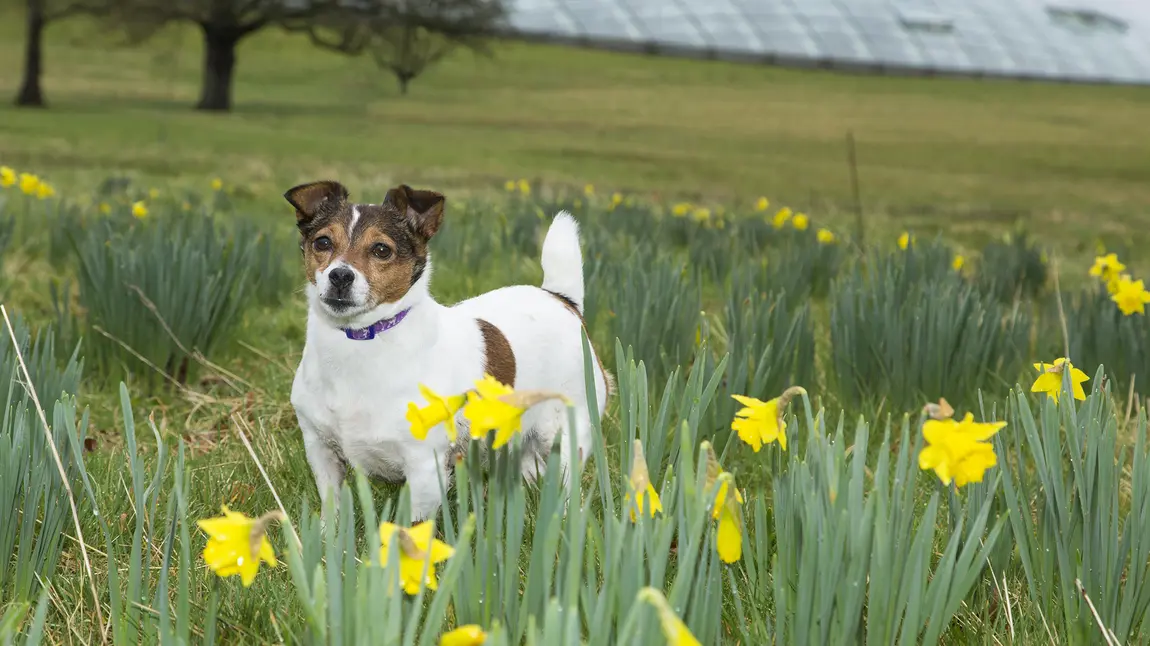Daffodils, dogs and St David: £6m to Wales’ National Botanic Garden

As Wales celebrates St David’s Day, its National Botanic Garden is in full bloom thanks to a multi-million pound investment from the National Lottery.
Recognised as the world’s youngest national botanic garden, horticulture will now meet history in Carmarthenshire’s 226-hectare site as a funding boost of £6m will help restore its Grade II listed Regency landscape to its former glory - with the reinstatement of interconnecting 18th-century lakes, cascades, bridges and dams.
Baroness Kay Andrews, UK Trustee and Chair of the Heritage Lottery Fund (HLF) in Wales, said: “Thanks to National Lottery players, the complete heritage of this important landscape will now be saved for future generations to appreciate, while adding a fascinating new dimension to one of Wales’ premier tourist attractions.
“Once completed, this exciting project will confirm the Botanic Gardens’ place at the top of everyone’s to-do list. It will make not only an amazing day out for families and people of all ages and a must-see for those outside Wales and even further afield.
“Helping regenerate the economy of south west Wales by attracting new visitors and new jobs, the enhanced Botanic Gardens will ensure this area of Wales stands its ground in terms of both visitor numbers, cultural significance and as a place for everyone to have fun.”
Original estate owners, the Middletons, began to lay out formal gardens from the late 16th century using wealth gained from procuring spices, herbs and other goods as founders of the East India Company in the early 1600s.
But it was not until the estate was purchased by MP for Carmarthen, Sir William Paxton, in 1789 that the grounds came into their own.
Protégée of world-famous landscape architect, Capability Brown, Samuel Lapidge was commissioned to design the landscape and gardens to include an innovative water park with water flowing around the estate linked by a network of dams, sluices, bridges and cascades.
It is these ground-breaking water features that will be brought back to life for modern-day visitors to enjoy.
A specially designed mobile phone app will enable visitors to explore using interactive information and maps, transporting them back a few centuries at the touch of a screen.
The project will be made possible by more than 300 new volunteers who will be recruited to join the Garden’s existing team, while accredited training as part of the restoration work will mean four new apprenticeships will also be created.
While it will be some time before visitors can experience the splendour of the Middleton estate, there is still plenty on offer at the Botanic Gardens this Spring.
Dog owners can bring along their pooch in a new and highly popular Doggy Days scheme held every Monday, so no one has to miss out on what the Garden has to offer – two legs or four!
As well as taking in the beauty of Wales’ Springtime flowers, visitors can see their exotic counterparts in the Garden’s iconic Great Glasshouse designed by Norman Foster, which houses the largest collection of Mediterranean plants in the Northern Hemisphere and some of the most endangered species on the planet.
There’s also a brand new tropical butterfly house to enchant all ages, home to large, colourful butterflies with see-through wings and colour-changing abilities.
Huw Francis, Director of The National Botanic Garden of Wales, commented: “Spring has certainly sprung here at the Garden, with this fantastic news chiming in a fresh season and a fresh chapter in our history too – all at a time when we’re already welcoming other new and exciting attractions, such as the Doggy Days scheme.
“Since we opened at the start of the Millennium, we have always wanted to celebrate not only our horticulture but also our heritage.
“The house was destroyed decades ago through fire, but the impressive grounds have left plenty of traces in the form of drained or silted lakes and overgrown paths. This funding will mean we no longer have to imagine what the estate might have looked like, because we can now recreate it for our modern day visitors to experience first-hand. It will be spectacular.”
Ken Skates, Economy Secretary, said: “Our natural heritage is a precious resource, and combining the Botanic Garden’s horticulture expertise with its own history will make an exciting and powerful new visitor attraction for Wales.
“The Welsh Government is a proud supporter of the Botanic Gardens and we welcome this investment which will help provide new skills and training for volunteers and apprentices. As a Welsh Government we are keen to work with the Botanic Gardens and its partners to develop a sustainable future for this fantastic facility.”
Emlyn Dole, Leader of Carmarthenshire County Council, commented: “We know that more than 300,000 visitors come to Carmarthenshire every year, many of them wanting to find out more about our local history.
“The Botanic Garden occupies an incredibly important heritage site on the former Middleton estate, and having this history brought back to life will be very much welcomed by both local people and visitors to the area. The additional support this new attraction will bring to the local economy will help boost our tourism opportunities and hopefully interest people from across the UK.”
To plan your visit to The National Botanic Garden of Wales this Spring, please visit the Botanic Garden website.
Further information
- Deian Creunant on tel: 01970 636419 and via email: deian.creunant@four.cymru
- Amelia Taylor on tel: 01970 636407 and via email: amelia.taylor@four.cymru